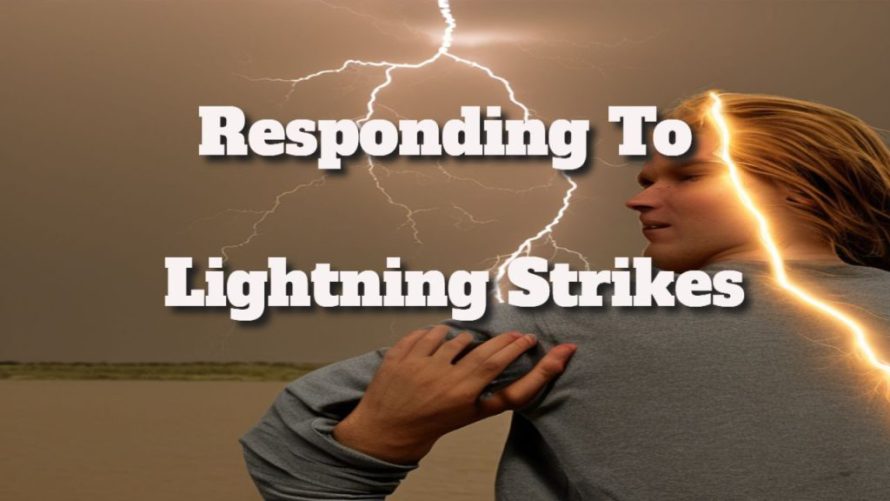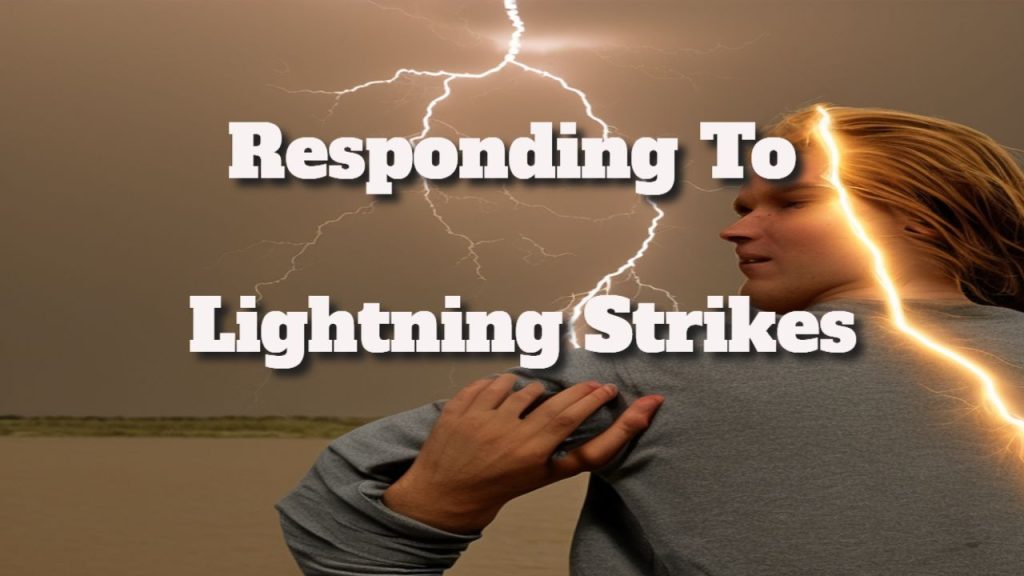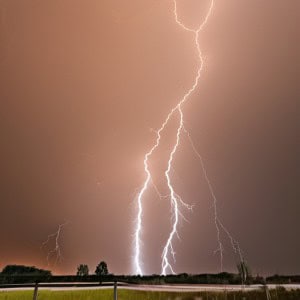Master Lightning Safety: Proven Strategies to Protect Yourself from Strikes
Unraveling the Mysteries of Lightning and Its Dangers
Lightning is a magnificent yet perilous natural phenomenon that captivates many with its sheer power and beauty. However, it brings with it a serious threat that necessitates our understanding to ensure our safety. By delving into the intricacies of lightning, we establish a firm groundwork for adopting effective safety measures that will be elaborated upon in later sections.
Essentially, lightning represents a sudden electrical discharge that occurs during thunderstorms, arising from the buildup and release of static electricity in the atmosphere.
Within thunderclouds, collisions between water droplets and ice particles cause a separation of electric charges: positively charged particles ascend to the upper regions of the cloud, while negatively charged particles gather at the base. This imbalance of charges sets the stage for the spectacular and sometimes dangerous lightning storms.
There are multiple types of lightning, each with distinct characteristics. The most common type, known as cloud-to-ground lightning, descends from the base of a thundercloud directly to the earth’s surface.
This particular type of lightning is infamous for its destructive power, striking with phenomenal speed and intensity. Another variety, cloud-to-cloud lightning, occurs between separate areas within the same storm cloud.
Cloud-to-cloud lightning often creates stunning flashes that light up the evening sky, offering a mesmerizing visual display that captures the attention of spectators.
While the stunning visual of lightning can be enchanting, it is imperative to remain cognizant of the inherent hazards it presents.
Lightning strikes can result in severe injuries or fatalities, with thousands of lives lost each year due to this natural hazard.
It’s important to recognize that lightning can strike even when a storm appears to be miles away, as the electrical charge can travel for extended distances. Understanding the risks associated with lightning is vital for enhancing our safety.
Armed with this knowledge, we can better appreciate the critical need for proactive safety measures. By deepening our understanding of lightning’s complexities, we can equip ourselves with effective strategies to mitigate the associated risks.
To gain a deeper insight into lightning generation, we must examine the various factors that contribute to its occurrence. Thunderstorms serve as the primary source of lightning, providing the essential components of moisture, unstable air, and updrafts.
When these elements come together, they create ideal conditions for spectacular electrical discharges. Thunderstorms commonly form in warm, humid climates where rising warm air interacts with cooler air masses.
The interplay between these contrasting air masses generates the necessary conditions for the development of thunderclouds, which are crucial for lightning formation.
The movement of air inside a thundercloud plays a pivotal role. Updrafts collide, causing tiny ice particles and water droplets to interact and create a separation of charges. This charge separation initiates the intricate process that ultimately results in lightning.
As positive and negative charges accumulate, a strong electric field develops within the cloud. Eventually, when this electric field reaches a critical intensity, a discharge occurs, manifesting as a lightning strike.
The capability of lightning to illuminate the intricate nature of our environment is truly remarkable. The different colors of lightning can indicate the composition of storm clouds.
For example, blue or purple lightning suggests the presence of ice particles, whereas yellow or red lightning points to dust or pollution within the cloud. By analyzing these characteristics, scientists can gain valuable insights into the meteorological conditions that favor lightning formation.
While the breathtaking beauty of lightning is captivating, it is crucial to remain mindful of the associated dangers of this powerful natural phenomenon. Lightning strikes occur at astonishing speeds, and their destructive potential must never be underestimated.
The upcoming sections will delve into the various safety strategies necessary for our protection in the event of a lightning strike.
By equipping ourselves with knowledge and implementing preventative measures, we can significantly reduce the risks and protect ourselves from lightning strikes. Let’s embark on this enlightening journey together to uncover the secrets of lightning strike safety.
Proven Safety Measures to Prevent Lightning Strikes
When lightning strikes, it becomes a universal threat, as this powerful natural force can strike suddenly and without any prior warning.
Establishing safety procedures and protective measures is crucial to ensure your safety during a lightning event. By doing so, we can minimize the risk of being struck and safeguard ourselves, as well as those around us.
The foremost precaution during an approaching thunderstorm is to remain indoors. This action provides the highest level of protection from potential lightning strikes. Ensure that you take shelter in a sturdy building, particularly one equipped with a lightning protection system.
Avoid seeking refuge in open garages, picnic shelters, or any other structures that lack adequate protection. Keep your distance from windows, doors, and electrical devices while indoors during a thunderstorm.
If finding indoor shelter is not possible, seek appropriate temporary refuge. Steer clear of isolated trees, wide open fields, or large metal structures, as these can act as lightning rods.
To minimize the risk of a direct strike, find a low-lying area, away from potential lightning rods, and lie flat with your hands covering your ears.
It’s also essential to be aware of lightning safety protocols in various outdoor situations. Always check weather forecasts before engaging in outdoor activities such as hiking, golfing, or swimming.
By seeking cover or avoiding outdoor activities during thunderstorms, you can significantly reduce your risk of being struck by lightning.
Remember, minimizing your chances of being struck by lightning is critical for your safety. By staying indoors, seeking proper shelter, and understanding lightning safety recommendations, we can effectively protect ourselves and those around us.
However, safety measures extend beyond these basic actions. By taking proactive steps, individuals can further reduce their risk of lightning strikes and ensure their safety during thunderstorms.
Avoiding contact with water during rainstorms is a vital safety measure. Being in or near water increases the risk of lightning strikes, as water is an excellent conductor of electricity.
If you’re engaged in activities such as swimming or boating, exit the water immediately upon hearing thunder or spotting lightning. Remain indoors or inside a fully enclosed vehicle until the storm has passed.
Additionally, understanding the “30-30 rule” is crucial for safety during thunderstorms.
If there are fewer than 30 seconds between seeing lightning and hearing thunder, take cover immediately. It is also advisable to remain safe indoors for at least 30 minutes after the last flash of lightning or rumble of thunder.
Creating an action plan for outdoor sports and recreational activities is essential. Coaches, organizers, and participants should establish clear guidelines for lightning safety.
In anticipation of forecasted thunderstorms, it is vital to halt all activities and move everyone to a designated safe location.
To eliminate unnecessary risks, outdoor sporting events, such as golf tournaments or football games, can be postponed or rescheduled.
Educating children, youth, and adults about lightning safety at home and in schools is also a crucial aspect of safety planning.
By raising awareness of lightning dangers and safety practices, individuals can make informed decisions to protect themselves during thunderstorms.
A comprehensive approach that combines practical safety measures, precautions, and advanced strategies is essential for ensuring safety during thunderstorm events.
By avoiding water during thunderstorms, understanding the 30-30 rule, developing action plans for outdoor activities, and promoting awareness of lightning safety, we can significantly lower the likelihood of lightning strikes.
Stay vigilant and informed, as your safety and the safety of those around you should always be a top priority.
Key Response Strategies When Facing Lightning Strikes
Lightning strikes can happen without any warning and pose a serious threat to our lives. Understanding the proper protocols, including first aid techniques, calling for help, and assisting injured individuals, is essential in these critical situations.
First and foremost, personal safety must be prioritized in the event of a lightning strike. If you find yourself outdoors during a thunderstorm, take cover immediately.
Avoid wide-open spaces, tall isolated structures, and any bodies of water, as these can serve as conductors for lightning. Seek shelter in a sturdy building or a fully enclosed vehicle with closed windows. Refrain from sheltering under trees or in temporary structures, as these offer minimal protection.
Once you have secured suitable shelter, adhere to safety guidelines. Remember that electrical appliances, plumbing fixtures, and telephones can conduct electricity.
Avoid showering or bathing during a thunderstorm, as water is a highly efficient conductor of electricity. Stay away from windows, doors, and concrete walls, which lightning can penetrate.
If someone is struck by lightning, quick action is crucial. Assess the individual’s breathing and pulse. If either is absent, call 911 and initiate cardiopulmonary resuscitation (CPR) if you are trained.
Starting resuscitation as soon as possible can significantly increase the chances of survival. If the victim is conscious but injured, provide assistance until medical help arrives.
In the event of a lightning strike, every second counts. Stay calm, act swiftly, and ensure the safety of everyone involved by following the necessary protocols. By understanding these procedures, we can protect ourselves and those around us from the dangers of lightning strikes.
With this knowledge, we can be better prepared for emergencies that may arise from lightning strikes. We will delve into advanced first aid procedures relevant to these situations and emphasize the significance of being informed and connected.
Be prepared for the unexpected, as emergencies can occur in an instant. Knowledge and readiness are paramount to safeguarding ourselves and others during lightning strikes.
By familiarizing ourselves with advanced first aid techniques and staying educated on critical response measures, we enhance our ability to respond effectively to lightning strike incidents.
Exercise caution when administering first aid to anyone struck by lightning. Remember that even in the absence of visible signs, lightning can cause severe burns and internal injuries.
Start by assessing the individual’s airway, breathing, and circulation. If the person is unresponsive or lacks a pulse, call 911 immediately and begin CPR if you are trained.
Initiating resuscitation promptly can dramatically enhance survival rates.
While waiting for medical assistance, focus on anyone who is unconscious but injured. Always keep in mind the four primary goals in these critical situations:
- Stabilize the individual.
- Maintain appropriate body temperature.
- Minimize the risk of further injuries.
- Ensure the individual receives medical care as soon as possible.
If the person is experiencing difficulty breathing, has burns, or exhibits chest pain, immediate medical attention is crucial.
Discussing the importance of being informed and connected during lightning events is vital. Weather conditions can shift rapidly, making it essential to stay updated about impending severe weather to take preventative actions.
Stay informed about severe weather alerts by regularly checking forecasts, listening to local news, or utilizing weather apps. Maintain communication with family, friends, or colleagues to ensure everyone is aware of safety protocols and can assist if needed.
Understanding advanced first aid techniques and remaining current on lightning safety enables us to respond effectively and protect those at risk.
Remember, while lightning strikes are unpredictable, we can safeguard ourselves by arming ourselves with knowledge and remaining vigilant. Stay safe, informed, and prepared for the unexpected.
The Article Lightning Strike Protection: Stay Safe During Storms Appeared First On Survival Avenue.
Emergency Family Plan: Universal Preparation Guide
Comprehensive Elements to Include in Your Family Emergency Plan Effective Communication Strategies for Emergencies Emergency Family Plan: Establishing effective communication strategies is absolutely vital for ensuring that family members remain connected and informed during emergencies. It’s crucial to have clear, reliable methods in place that everyone understands and can utilise effortlessly. This encompasses traditional communication […]
Survival Water Bottles: Essential Gear for Emergencies
Why Survival Water Bottles are Essential for Emergency Preparedness Understanding the Significance of Hydration in Crisis Situations Survival Water Bottles: Maintaining hydration is vital for ensuring optimal bodily functions during emergencies. In scenarios where access to clean water is limited, sustaining proper hydration is crucial in preventing health complications associated with dehydration, which can include […]
Water Safety in Crises: Essential Tips and Strategies
The Crucial Role of Water Safety During Crises Identifying Water-Related Risks in Crisis Situations Water Safety in Crises: Crises arising from natural disasters, such as floods and hurricanes, or from human-induced events, like conflicts, frequently heighten water-related risks. During these challenging times, the security and quality of water supplies can be severely compromised, leading to […]
Survival Radio Options: Essential Gear for Emergencies
Comprehensive Guide to Different Types of Survival Radios Portable Handheld Radios for Emergency Situations Survival Radio Options: Portable handheld radios are essential components of any effective survival strategy, providing unparalleled portability and user-friendliness during emergencies. These devices are specifically engineered to be lightweight, making them perfect for activities like hiking, camping, or preparing for unforeseen […]









Your exploration of lightning as both a captivating natural phenomenon and a serious safety concern resonates deeply with anyone who has experienced the raw power of a thunderstorm. It’s striking (no pun intended) how many people are awe-inspired by lightning yet underestimate its dangers. Your explanation of the charge separation process within thunderclouds beautifully captures the science behind this natural spectacle, and it’s clear that understanding this phenomenon is crucial.
It’s true that lightning captures our imagination in ways that few other natural events can, yet it’s remarkable how often its dangers are overlooked. I remember a summer evening where I witnessed a storm brewing in the distance, the clouds darkening and rumbling. Watching the lightning flash was mesmerizing, but it also reminded me of the stories I’d heard about people struck by lightning—some of whom were just enjoying the moment in the wrong place.
I recently came across a piece that offers practical insights on navigating extreme weather conditions, and it really complements the discussion about the awe and hazards of phenomena like lightning.
‘Extreme Weather Conditions – Essential Survival Tips’
https://survivalbite.com/extreme-weather-conditions-essential-survival-tips/.
You bring up an essential point about how lightning can mesmerize us while hiding its dangers. It’s easy to get lost in the beauty of those flashes against a darkened sky, but the reality is that lightning isn’t just a stunning visual—it can be deadly. Your memory of witnessing that storm paints a vivid picture of the mixed sensations we experience during these weather events, a blend of fascination and respect for nature’s power.
Thank you for sharing your experience and insights! If you’re interested in learning more about staying safe during extreme weather events, I recommend checking out this informative piece on essential survival tips—it complements your thoughts perfectly.
https://survivalbite.com/wild
You make such a great point about the duality of lightning—it really is a captivating spectacle that reminds us of nature’s raw power. I remember standing on my porch during a particularly intense storm, the sky alive with electric blue streaks. It’s almost like a reminder that nature operates on a different level entirely, a blend of beauty and danger that we often overlook in our busy lives.
You’ve captured a fascinating duality in how we perceive lightning. It really is awe-inspiring, isn’t it? I remember watching a thunderstorm roll in as a kid, feeling that mix of excitement and fear as the sky lit up and the thunder roared. It’s such a visceral experience, and I think you’re spot on about how it can easily be underestimated.
It’s interesting you mention that mix of excitement and fear. It’s almost like our primal instincts kicking in—on one hand, there’s this raw beauty to a storm that can really capture our imagination; on the other, there’s that undercurrent of danger that keeps us grounded. I think a lot of people feel that pull, especially when they’re kids.
You bring up such an interesting point about the mix of excitement and fear during storms. It really does tap into those primal instincts we all have. As a kid, I remember feeling both exhilarated and terrified when a storm rolled in. The dark clouds would seem to promise adventure, while the thunder served as a reminder of nature’s raw power.
It’s interesting how lightning can evoke such a mix of awe and fear, isn’t it? I remember watching a particularly intense thunderstorm once, feeling that rush of excitement and a bit of anxiety at the same time. It really highlights how nature can be both beautiful and dangerous.
I totally get what you mean about the mix of emotions that storms can bring. There’s something about watching the skies light up and hearing that booming thunder that feels both exhilarating and a little unnerving. I remember a storm from a few years back that rolled in unexpectedly; the air felt charged and alive, and I found myself both drawn to the window and hesitant to go outside.
I can relate to that feeling of being drawn to the window while also feeling the urge to stay inside. Storms have this ability to create such a unique atmosphere; it’s like nature amplifying every sense. That charged air you mentioned can be almost intoxicating—it’s like a reminder of something primal in us.
It’s interesting how storms can evoke such a powerful mix of feelings. That feeling of the air being charged and alive really captures the essence of those moments. It’s almost like nature is reminding us of its power and unpredictability. I’ve had similar experiences; standing by the window, caught between the beauty of nature’s display and that instinctual urge to be cautious.
It really is fascinating how a single storm can trigger such a broad spectrum of emotions. That rush of excitement mixed with anxiety makes perfect sense—there’s something primal about our reactions to nature’s raw power. It’s a reminder of just how small we can feel in the grand scheme of things, yet at the same time, there’s beauty in that force.
Absolutely, that mix of emotions is what makes nature so captivating! If you’re interested in exploring more about the wonders and power of storms, check out this insightful article.
https://survivalbite.com/wild
I totally get what you mean about that mix of excitement and anxiety during a thunderstorm. There’s something almost primal about experiencing nature at its rawest, isn’t there? I remember a summer evening when a lightning storm rolled in—watching the sky light up and feeling the vibrations of thunder really made me appreciate the sheer power of our environment.
This exploration of lightning and its underlying physics is both fascinating and crucial for promoting safety awareness. It’s intriguing how such a visually stunning phenomenon carries potential dangers that are often underestimated. I’ve recently been reflecting on how inadequate our understanding of natural elements like lightning can be, especially given the increasing frequency of severe weather events attributed to climate change.
Your reflection on lightning really resonates with me. It’s fascinating to think about how something so visually striking can actually evoke a sense of vulnerability due to its unpredictable nature. I often find myself pondering the gap between our fascination with natural phenomena and our understanding of them. The way lightning forms and the science behind its unpredictability can feel like a mystery, yet it holds significant implications for safety and preparedness.
Your exploration of lightning safety strikes a chord with anyone who’s experienced a thunderstorm. It’s interesting how this phenomenon, often viewed merely as a spectacle, carries significant dangers that we sometimes overlook. I recall a summer evening as a child, watching lightning illuminate the sky from my bedroom window with a mix of awe and fear. It wasn’t until years later that I learned just how treacherous lightning could be and the essential precautions one should take during a storm.
It’s fascinating how our childhood experiences shape our understanding of nature and its perilous beauty. That blend of awe and fear you felt while watching lightning is something many of us can relate to—it’s like the raw power of the storm pulls at our curiosity while also reminding us of nature’s unpredictability.
You’ve captured that essence perfectly. It’s a strange dance, isn’t it? How nature intrigues us while keeping us at a distance. Watching lightning is more than just a show; it’s like witnessing raw emotion expressed in flashes of brilliance. It reminds us that with beauty often comes unpredictability.
It really is remarkable how those early experiences stick with us, isn’t it? I still remember the first time I witnessed a thunderstorm as a kid—how the sky darkened and the air felt charged with electricity. The mix of excitement and fear, like I was witnessing something both beautiful and utterly beyond my control, has stayed with me.
It’s fascinating how those formative experiences shape our perceptions, isn’t it? Your memory of that thunderstorm captures the duality of nature so beautifully. It’s like our young minds are hardwired to find wonder in the unpredictable, which often sparks a lifelong curiosity. That mix of excitement and fear you felt mirrors a lot of what life throws at us.
“Absolutely! Those childhood moments leave lasting impressions. If you’re interested in exploring more about how our experiences shape us, check out this fascinating article!”
https://survivalbite.com/LostFoods
Your exploration of lightning and its dangers truly underscores how we often overlook the raw power of nature, don’t you think? I’ve always been fascinated by how something so beautiful can also be incredibly treacherous. I remember watching a distant storm while camping once—pure awe mixed with a sense of vulnerability. It really hit home how crucial it is to understand the science behind lightning and the safety measures we can take.
Your exploration of lightning safety is both timely and essential, especially as we move into months where thunderstorms are more frequent phenomena. The dynamics of lightning strikes, particularly the impressive yet dangerous interplay of electrical charges within thunderclouds, underscore the need for a comprehensive understanding of this natural phenomenon. Indeed, while the visual spectacle of lightning captures our imagination—reminding us of nature’s raw power—it’s crucial not to overlook the serious implications it poses, particularly in terms of safety.
I’ve always found lightning to be both fascinating and terrifying. It’s incredible how something so stunning can be so dangerous, and your post really captures that duality well. Growing up in a region prone to summer thunderstorms, I can still remember the thrill mixed with a tinge of fear every time the sky lit up. It wasn’t just the sound of thunder that would send shivers down my spine; it was knowing the raw electricity was all around us, ready to unleash its fury.
It’s interesting how intense weather can shape our memories and emotions. That blend of thrill and fear really resonates. In many ways, lightning captures nature’s unpredictability. Growing up in areas prone to storms adds to that dynamic; it’s almost like an unspoken pact with the elements—acknowledging their beauty and their danger.
I completely relate to your experience! There’s something about the way a summer thunderstorm builds up—heavy clouds rolling in, the air thickening, and that unmistakable electric charge that makes everything feel alive. It’s a reminder of nature’s power in its most raw form. Sometimes, I think that thrill you mentioned is a connection to something primal within us; we’re drawn to beauty but also respect its potential danger.
“I’m glad you enjoyed the exploration of that duality! If you’re interested in learning more about the science behind thunderstorms and lightning, check out this resource that dives deeper into their fascinating—but sometimes fearsome—nature.”
https://survivalbite.com/LostFoods
The complexity of lightning and its underlying physics is indeed fascinating, and your insights highlight the importance of understanding this natural phenomenon. I recently read about advances in lightning detection technology, which enhances our ability to predict storms and tailor safety measures accordingly. These innovations not only protect individuals during severe weather but also play a crucial role in protecting infrastructure, especially in regions prone to thunderstorms.
You’ve touched on such an important aspect of lightning research—how these advances in detection technology are really changing the way we understand and interact with severe weather. It’s exciting to see how improved detection methods not only enhance our safety but also provide invaluable data for scientists studying the intricate dynamics of thunderstorms.
It’s fascinating how lightning, something so beautiful, can also be so deadly. I’ve always found thunderstorms a bit thrilling, but after learning about the real dangers of lightning, I’ve definitely changed my approach to those stormy days. I remember a camping trip where we got caught in a storm, and we huddled under a tree thinking it would be safe since it provided shelter. I wish I had known back then what happens to the charges in a thundercloud!
Your exploration of lightning and its inherent dangers is both fascinating and necessary, especially considering how often we find ourselves outdoors during thunderstorms. I remember a camping trip where a sudden storm caught my friends and me off guard. We had to scramble for safety, but it made me realize how little most of us know about proper lightning safety measures.
It sounds like your camping trip was quite an eye-opener. Those moments when nature abruptly shifts gears can be jarring, especially when you’re caught off guard. Many people share your experience of realizing just how unprepared they are during sudden storms. It’s interesting how being in the midst of those unpredictable conditions brings the importance of safety to the forefront of our minds.
Your exploration of lightning safety shines a much-needed light on an often-overlooked aspect of nature’s beauty. It’s fascinating to think about the incredible forces at play in the atmosphere and how these powerful phenomena can affect our daily lives. Lightning, with its stunning visual display, is a reminder of the raw power of nature, yet it also compels us to cultivate a deeper respect for our environment.
It’s fascinating to think about how something as beautiful as lightning can also be so dangerous. Your post does an excellent job of explaining the science behind it. I remember the first time I saw a summer storm roll in with that dramatic sky lit up by flashes of lightning. It was mesmerizing, but I was definitely a bit nervous about the power contained in those strikes.
It really is interesting to think about that balance between beauty and danger in something like lightning. I’ve had a similar experience watching a summer storm roll in. There’s something almost primal about those dark clouds and the way the air feels charged, isn’t there? It’s like nature is putting on a show, but you can’t ignore how powerful it is.
It’s fascinating how something as beautiful as lightning can also have such a hidden danger lurking behind it. I remember watching a lightning storm once, absolutely mesmerized by the flashes, but it also made me reflect on the sheer power of nature and our vulnerability. There’s definitely something deeply humbling about it.
It’s so interesting to think about how something as beautiful as lightning can also be incredibly dangerous. I’ve always been a bit fascinated by storms, but I’ve learned to respect their power. I remember a camping trip where we were caught in a thunderstorm, and the fear of a lightning strike really hit home. We had to huddle in the car for safety until it passed, which gave me a lot of time to think about how unprepared most people are in these situations.
It’s fascinating how lightning serves as a reminder of nature’s incredible forces while also highlighting the importance of safety measures. I remember a camping trip where we were caught in a sudden thunderstorm, and the rumble of thunder completely shifted our perspective on storms. Understanding the science behind lightning, like the charge separation you mentioned, really brings the thrill and danger into focus.
It’s fascinating how something as beautiful as lightning can also pose such significant risks. I remember being caught in a thunderstorm while hiking a few years ago, and it made me acutely aware of the dangers. I had always thought of lightning as a dramatic backdrop to summer storms until I learned about the science behind it. The way you break down the charge separation within clouds clarifies just how complex this natural event is.
Your exploration of lightning’s mechanics is incredibly informative, and it highlights a crucial aspect of nature that often goes misunderstood. I think it’s fascinating how the electrical charges in thunderclouds can lead to such a violent discharge, yet it also raises questions about humanity’s relationship with nature.
It’s fascinating to think about lightning not just as a beautiful natural occurrence but as a compelling reminder of the power of nature. Your breakdown of how electric charges form in clouds makes the science behind it much clearer. I find it intriguing how, in some cultures, lightning is seen as a divine message or a symbol of power, which underscores our ancient relationship with nature’s forces.